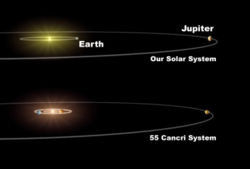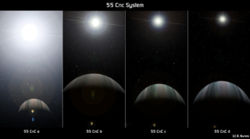55 Cancri
2007 Schools Wikipedia Selection. Related subjects: Space (Astronomy)
| Observation data Epoch J2000.0 |
|
|---|---|
| Constellation | Cancer |
| 55 Cancri A | |
| Right ascension | 08h 52m 35.8s |
| Declination | +28° 19′ 51″ |
| Apparent magnitude (V) | 5.95 |
| 55 Cancri B | |
| Right ascension | 08h 52m 40.9s |
| Declination | +28° 19′ 59″ |
| Apparent magnitude (V) | 13.15 |
| Characteristics | |
| Spectral type | G8V / M3.5-4V |
| B-V colour index | 0.86 / 1.66 |
| U-B colour index | 0.65 / 1.21 |
| Variable type | none / ? |
| Astrometry | |
| Radial velocity (Rv) | 27.3 km/s |
| Proper motion (μ) | RA: -485.46 mas/ yr Dec.: -234.40 mas/ yr |
| Parallax (π) | 79.80 ± 0.84 mas |
| Distance | 40.9 ± 0.4 ly (12.5 ± 0.1 pc) |
| Absolute magnitude (MV) | 5.46 / 12.66 |
| Details | |
| Mass | 0.95 / 0.13 M☉ |
| Radius | 1.1 / 0.30 R☉ |
| Luminosity | 0.61 / 0.0076 L☉ |
| Temperature | 5240 / ? K |
| Metallicity | 186% / ? |
| Rotation | 42 days / ? |
| Age | 5.5 × 109 years |
| Other designations | |
|
ρ1 Cancri, Gl 324, BD +28°1660, HD 75732
55 Cancri A HR 3522, LHS 2062, LTT 12310, GCTP 2117.00, SAO 80478, LFT 609, HIP 43587 55 Cancri B LHS 2063, LTT 12311, LFT 610 |
|
55 Cancri (abbreviated 55 Cnc) is a binary star located around 40 light-years away in the constellation Cancer. It has the Bayer designation Rho1 Cancri. The system contains a yellow dwarf star (55 Cancri A) similar to our Sun and a red dwarf (55 Cancri B). The two components are separated by over 1000 times the distance from the Earth to the Sun.
As of 2004, four extrasolar planets are known in orbit around 55 Cancri A. Three of the planets are comparable to Jupiter in mass, while the innermost planet has a mass similar to that of Neptune. The 55 Cancri system was the first known four-planet extrasolar planetary system.
55 Cancri A is ranked 63rd in the list of top 100 target stars for the NASA Terrestrial Planet Finder mission.
Distance and visibility
The 55 Cancri system is located fairly close to our solar system: the Hipparcos astrometry satellite measured the parallax of 55 Cancri A as 79.80 milliarcseconds, corresponding to a distance of 12.5 parsecs. 55 Cancri A has an apparent magnitude of 5.95, making it visible through binoculars. It is just visible to the naked eye under very dark skies. The red dwarf 55 Cancri B is of the 13th magnitude and only visible through a telescope.
System components
55 Cancri A is a yellow dwarf star of spectral type G8V. It has a similar mass to our Sun, but is cooler and less luminous. The star is more enriched than our sun in elements heavier than helium: it is classified as a rare "super metal-rich" main sequence star and has around 186% the solar abundance of iron. This abundance of metal makes estimating the star's age and mass difficult, as evolutionary models are less well defined for such stars. One estimate based on chromospheric activity suggests an age of around 5,500 million years.
55 Cancri B is a red dwarf star located at an estimated distance of 1065 AU from the primary star, and is much less massive and luminous than our Sun. There are indications that this star may itself be a double star, though this is by no means certain.
Planetary system
In 1997, the discovery of a 51 Pegasi-like planet orbiting 55 Cancri A was announced, together with the planet of Tau Boötis and the inner planet of Upsilon Andromedae. The planet was discovered by measuring the star's radial velocity, which showed a periodicity of around 14.7 days corresponding to a planet at least 78% of the mass of Jupiter. This planet was designated 55 Cancri b, though to distinguish it from the star 55 Cancri B it is occasionally referred to as 55 Cancri Ab. The radial velocity measurements still showed a drift unaccounted-for by this planet, which could be explained by the gravitational influence of a more distant object.
In 1998 discovery a possible dust disk around 55 Cancri A was announced. Calculations gave the disk radius at least 40 AU, similar to the Kuiper belt in our solar system, with an inclination of 25° with respect to the plane of the sky. However, the discovery could not be verified and was later deemed to be spurious, caused instead by background radiation.

After making further radial velocity measurements, a planet orbiting at a distance of around 5 AU was announced in 2002. This planet received the designation 55 Cancri d. At the time of discovery, the planet was thought to be in an orbit of mild eccentricity (close to 0.1), however this value was increased by later measurements. Even after accounting for these two planets, a periodicity at 43 days remained, possibly due to a third planet. Measurements of the star suggested that this was close to the star's rotation period, which raised the possibility that the 43-day signal was caused by stellar activity. This possible planet received the designation 55 Cancri c.
In 2004 a Neptune-mass planet designated 55 Cancri e was announced in a 2.8-day orbit. This planet may either be a small gas giant or a large terrestrial planet. The measurements that led to the discovery of this planet also confirmed the existence of 55 Cancri c. In addition, astrometric measurements made by the Hubble Space Telescope led to an estimate of the inclination of the orbit of the outer planet: around 53° with respect to the plane of the sky. Assuming the system is coplanar, this means the true masses of the planets are around 25% greater than the lower limits measured by the radial velocity method.
In 2005 the existence of planet e was questioned by Jack Wisdom in a reanalysis of the data. According to him, instead of the 2.8-day planet there is a planet with a mass similar to that of Neptune in a 261-day orbit (corresponding to 0.77 AU in distance). This analysis has not been confirmed.
Without taking the unconfirmed 261-day planet into account, simulations suggest that there is a wide stable region between the orbits of planets c and d which could contain additional planets. Models predict that one or more terrestrial planets could form in this gap, though such planets would be undetectable with present-day technology. This is of astrobiological interest since this region includes 55 Cancri A's habitable zone.
| Companion (In order from star) |
Mass ( MJ) |
Orbital period (days) |
Semimajor axis ( AU) |
Eccentricity |
|---|---|---|---|---|
| e | >0.045 ± 0.01 | 2.81 ± 0.002 | 0.038 ± 0.001 | 0.174 ± 0.127 |
| b | >0.784 ± 0.09 | 14.67 ± 0.0006 | 0.115 ± 0.003 | 0.0197 ± 0.01 |
| c | >0.217 ± 0.04 | 43.93 ± 0.021 | 0.240 ± 0.005 | 0.44 ± 0.08 |
| d | >3.92 ± 0.5 | 4517.4 ± 77.8 | 5.257 ± 0.9 | 0.327 ± 0.28 |

